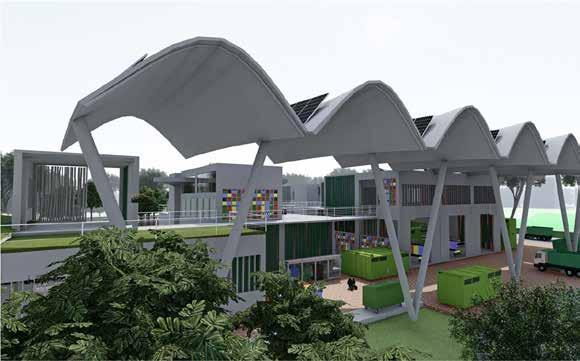

SWAYAM THE WASTESCAPE COMMUNITY
HANDBOOK FOR SWM RECOVERY FACILITY
EDITOR -NEHA PATIL
GUIDANCE –DR. POORVA KESKAR


CLOTHES

ITS FAST FASIHON


CHIPS PACKET
WE LOVE PLASTIC



FOOD
HUNGER PROBLEMS

PHONE
UPDATED VERSION
SP OT ME





- While waste is defined as any discarded or unwanted object or element that has been rejected or damaged, the neglected materiality of waste and the invisible processes of decomposition are as significant as the processes of growth in the city

India generates 62 million tonnes of waste each year. About 43 million tonnes(70%) are collected, of which about 12 million tonnes are treated, and 31 million tonnes are dumped in landfill sites.
W A S T E
Unwanted Object(element) -Rejected -Damaged
ALARMING ISSUE
G A R B A G E
P L A S T I C
W A S T E

WASTE STATISTICS
Waste generation in India is a significant environmental and societal challenge due to its large population and rapid urbanization.
Municipal Solid Waste (MSW)
Municipal solid waste includes household waste, commercial waste, and waste from streets and public places.
India generates around 150,000 tons of municipal solid waste per day. Only about 80-85% of this waste is collected, and less than 30% is treated and processed properly.

62 MILLION TONS / YEAR
3.4 MILLION TONS / YEAR
619 TONS / DAY
7.1 LAKH TONS / YEAR (31% INCREASE / YEAR)
12 MILLION TONS / YEAR
4.3 MILLION TONS / YEAR
350 MILLION TONS / YEAR
ARE THESE NUMBERS JUST WASTE PRODUCTION AND NOT ASSETS FOR CIRCULAR ECONOMY ?

MOBILITY OF WASTE
• TRUCK
• VAN
• RAIL
• SHIP
LANDFILL
• CARBON EMMISION
• GLOBAL WARMING
• WASTE INEFFICIENT
Carbon emissions in waste mobility refer to the greenhouse gas emissions produced during the transportation of waste materials from their source to various destinations, such as landfills, recycling facilities, or incineration plants. The amount of emissions generated during waste transportation can vary based on several factors, including the distance traveled, the mode of transportation, the type of waste being transported, and the efficiency of the transportation process.
Transportation Modes: The choice of transportation mode significantly impacts carbon emissions. Common modes for waste transportation include trucks, trains, ships, and, in some cases, air transport. Each mode has its own energy efficiency and emissions profile.



Distance: The distance over which waste is transported plays a crucial role in emissions. Longer transportation distances generally result in higher emissions. Waste transported over short distances within a city may have lower emissions compared to waste transported across regions or internationally.
 CO2
CO2

India generates approximately 2.2 million tons of E -waste annually.
WASTE -WISE INDIAN CITIES
INDIA’S CLEANEST CITIES
Inspiration from Best practices in municipal solid waste management


Situation Indore before : 1000 Vulnerable Garbage Points


< 50kg –Door collection
> 50kg -BWG,s Bulk Waste Generators
Door to door collection
Awareness programme
Collection regular service
Ward zoning
Tricycle or auto trippers collection
10 wards expansion Entire city door to door collection
Campaign for source segregation Separate bins Sanitary and hazardous waste segregation 6 categories 1)Biodegradable 2)Non-bio 3)Plastic 4)Sanitary
5)Electronic 6)Hazardous Waste segregation










LEARNING ENVIRONMENT SUSTAINABILITY SOLUTION


WASTE MANAGEMENT CENTRE PROJECTS
EXPLORE THE WASTE WONDERS
Pick some inspiration from real-world projects of amazing waste management architecture

COPENHILL ENERGY PLANT AND URBAN RECREATION CENTER, BIG
AmagerBakke or CopenHillis an excellent example of interactively engaging citizens with the waste to energy plant.
The CopenHill, as the name suggests creates a man-made hill in the otherwise flat landscape of Copenhagen and provides its citizens with a surface to ski-on. .

The plant converts 4,40,000 tons of waste annually into clean energy and delivers electricity and heat to nearly 1,50,000 homes
MIXED USE ARCHITECTURE, PUBLIC ARCHITECTURE, Community Center, Kamikatsu, Japan

The town of Kamikatsuin Tokushima Prefecture aims to become a sustainable recycling community and has pledged to produce zero waste.
Its recycling rate has already reached 80% by sorting trash into 45 categories, with used items displayed like a store at the recycling center.



Hotchkiss Biomass Power Plant / CenterbrookArchitects & Planners

The Hotchkiss Biomass Power Plant in Colorado exemplifies sustainable energy generation by converting biomass into electricity. This approach not only reduces reliance on fossil fuels but also addresses waste management challenges by repurposing organic materials. By providing economic benefits to the local community and mitigating environmental impacts, it serves as a model for integrating renewable energy and waste management practices.

The Plant, Chicago




The Plant is an innovative project in Chicago that transforms a former meatpacking plant into a net-zero energy vertical farm. It utilizes waste from one process as inputs for another, creating a closed-loop, circular system. The project aims to reduce waste while promoting urban farming and sustainable practices.


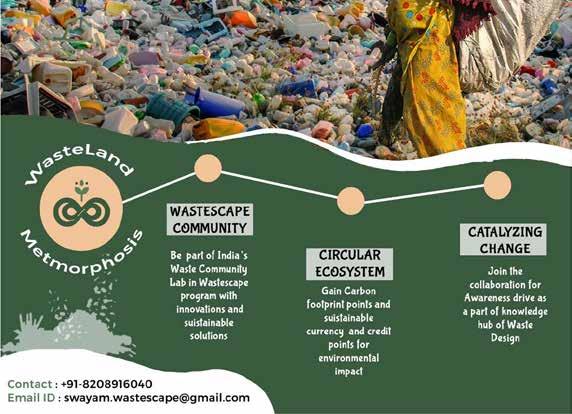
SWAYAM
THE WASTESCAPE COMMUNITY
ARCHITECTURAL INTERVENTION FOR WASTE MANAGEMENT
Lets do it by ourselves as an individual and community, since waste management is our responsibility


Swayam -The Wastescape Community Project
OBJECTIVE : To reshape societal perceptions by architecturally transforming waste into a valued asset and fostering sustainable thinking.
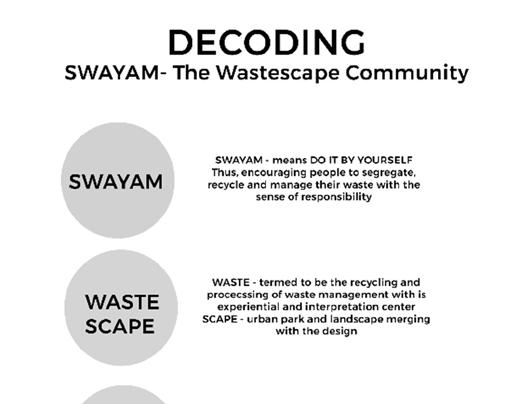
SWAYAM–THEWASTESCAPECOMMUNITYprojectembodies thephasesofdesignandurbanplanningtorevolutionizethe waypeoplethinkaboutwaste,redefiningvaluewithcircular economy,whereasbridgingthegapofwaste,technologyand entrepreneurs.




The 3 phases are 1st the city module by mapping the and analyzing the waste generation in Nashik the decentralization of waste recycling and the initial process in 6 sectors would be by setting up 6 material recovery centers in city which have connectivity to MNC waste management facility. 2nd is the design of wastescape center with a material recovery facility which is a community center with interpretation and an expertianalworkshop area with an exhibition and recreation park for public engagement. 3rd is collaborating with innovators, entrepreneurs, and urban local bodies and providing guidelines and aware for waste management.

WASTE PROCESSING CHART
WASTE COLLECTION
PUBLIC WASTE
COLLECTION AT MRF
Drop Waste at collection centre in AI
Waste Collector Give the waste at Waste Collection area of MRF
Weighing
Sorted Waste
Partial Sorted Waste
Mixed Waste
Unloading deck
MUNICIPAL CORPORATION GARBAGE VEHICLES
Magnetic Screening (detect metals )
Sorting the waste as per types by sizes handpicked on the Conveyor belt
Air Classifier (Separates the paper and plastic)
Conveyor belt with Hopper
Sorting Tables
Material Sorting in TROMMEL
Fertilizers packing and storage

WASTE PROCESSING PROCESS
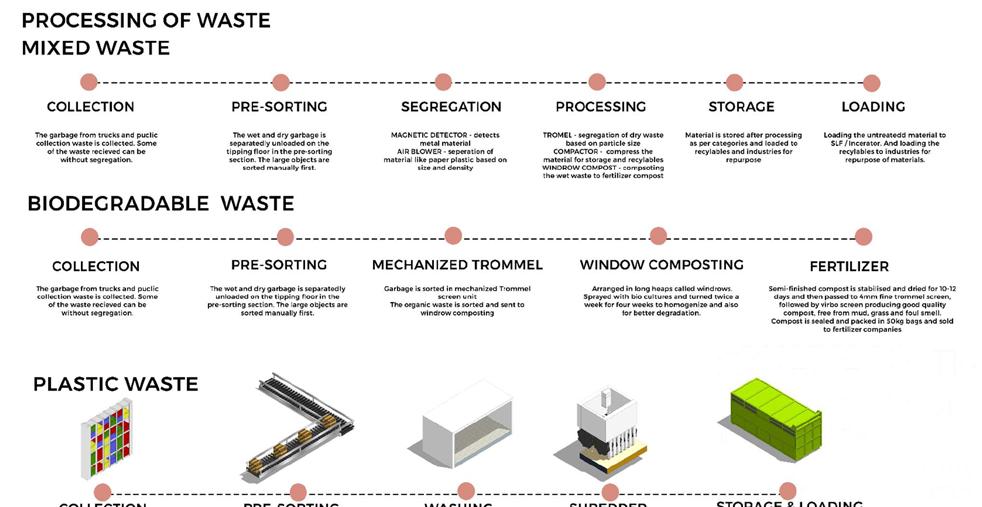


MATERIAL RECOVERY FACILITY ZONES











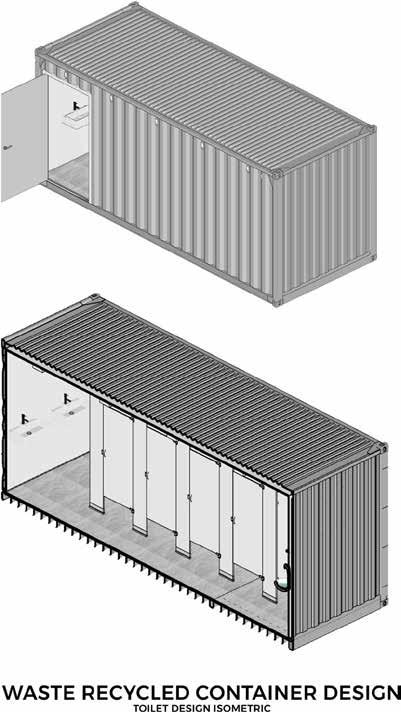


DESIGN MODULES
MODULAR DESIGN

PLUG AND CREATE YOUR MATERIAL RECOVERY CENTRE

FAST FASHION

India generates 7,800 kilotonnesof textile waste annually of Textile Waste annually.
CHEAP CLOTHING’S HIGH COST

NASHIK SWM
CITY CASE DEMONSTRATION MODEL
Nashik current Waste Management scenario with design demonstration for waste management in city with SWAYAM design proposal

Nashik Solid Waste Management Plant
•Place: Nashik, Maharashtra
•Scale: Daily 10 to 15 tons of food and vegetable waste from approximately 500 restaurants and 10 to 20 tons of septage from 400 community toilets are collected by trucks and delivered to the plant
•Area: 6000 sq.m, provided by Nashik Municipal Corp (NMC).
•Processing Capacity: 30 Tonne/day
•Operational since: December, 2017




DESIGN RECYCLING CENTRE
CL O THE S RECYCLING CENTRE
PA PE R RECYCLING CENTRE
PL A ST IC RECYCLING CENTRE
E - WAS TE RECYCLING CENTRE

S AN ITA RY WAS TE RECYCLING CENTRE
WE T WA ST E C OM POS TE R CENTRE
IN DUS TR IAL M A TE RIA L WASTE RECOVERY CENTRE

NASHIK MAP
Where should we set up recycling centreon nashikfor different typology of waste ?


Industrial waste
Textile waste
Plastic waste

Wet composter
E-waste
Paper waste
Bio-medical waste
Sanitary Waste
Agriculture Waste

MAP SWAYAM THE WASTESCAPE COMMUNITY IN YOUR CITY FOR RECOVERY OF DIFFERENT WASTE





MATERIAL RECOVERY FACILITY
DESIGN DEMONSTRATION
SWAYAM-The Wastescape Community in Nashik city as a material recovery facility in the sector of city.

SWAYAM –The Wastescape Community



Scan for more project details

MRF WASTE ACTIVTY ZONING
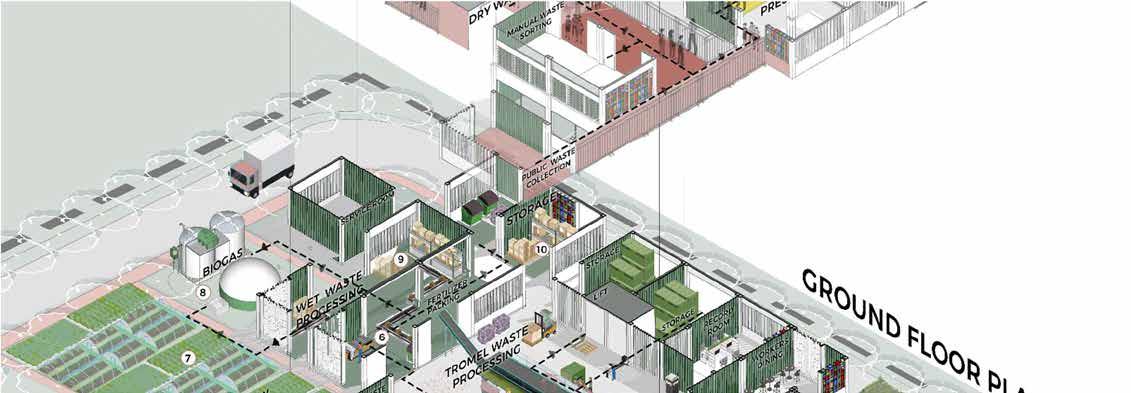


SWAYAM –The Wastescape Community




WASTE MATERIAL
EXPLORE USE OF WASTE MATERIAL IN CONSTRUCTION AND INTERIOR DESIGN


WINDOW MODULES
W1 W2 W3 W4W5




WINDOW MODULES WWR CALCULATION

WINDOW
MATERIALS
• Plastic Bottle
• Glass
• Waste Recycled Bins
• Bamboo Panels
• Louvers
• Waste Terracotta Tiles




Module Column
Exterior Panel
Waterproofing layer
Insulation filling material
Vertical support studs
Dry Wall Masonary

U-Value Calculation


Bamboo Vertical support studs
Module Column
Exterior Panel
Waterproofing layer
Dry Wall Masonary
Bamboo support studs
Module Column
Waterproofing layer
Plastic bricks wall
Plastic Bottles
Bamboo Vertical support studs
Module Column
Plastic bricks wall
Plastic Bottles

Bamboo Vertical support studs
Module Column
Bamboo Panel
Waterproofing layer
Waste Bricks Masonry
PVC Pipes support studs
Module Column
Waterproofing layer
Plastic bricks wall
Plastic Bottles
Bamboo Vertical support studs
Module Column
Bamboo Panel
Waterproofing layer
Dry Wall Masonry
Insulation filling material
Dry Wall Masonry

BAMBOO SLITS
WALL PANELS MATERIALS
WASTE MATERIAL BRICKS
RECLAIMED METAL VERTICAL STUDS

C& D WASTE BRICKS

AAC BLOCKS
WASTE MATERIAL BRICKS
RECLAIMED METAL VERTICAL STUDS
PLASTIC BRICKS


U-Value Calculation


Bamboo Vertical support studs
Module Column
Bamboo Panel
Waterproofing layer
Dry Wall Masonary
CONSTRUCTION DETAILS
Vertical support studs
Module Column
Exterior Panel
Waterproofing layer
Insulation filling material
Dry Wall Masonary

Bamboo Vertical support studs
Module Column
Exterior Panel
Waterproofing layer
Dry Wall Masonary
Insulation filling material
Dry Wall Masonary


CONSTRUCTION DETAILS
DESIGN YOUR COLUMN AND FOUNDATION SUSTAINABLE




PLASTIC BOTTLES CONSTRUCTION WASTE










SUSTAINABLE STRATERGIES
INCLUDE GREEN ENERGY IN DESIGN

Steps involved in obtaining biogas:
1.Hydrolysis- Enzymes convert large organic molecules into simpler units.
2.Fermentation- Organic materials are broken down by bacteria in anaerobic conditions.
3.Methane formation- Production of methane gas.
4.Spent slurry-Residue left after the formation of biogas.
Biogasisamixtureofgasesproducedbyanaerobicdegradation ofbiomassinthepresenceofwaterbutintheabsenceof oxygen.Methaneisthemajorcomponentofbiogas.

Abiogasplantconsistsofanundergroundtankcalleddigester, whichismadeofbricksandhasadome-shapedroof.Thedome actsasagas-holder.Thereisagasoutletatthetopofthedome havingavalve.Thereisaslopinginletchamberconnectedtoa mixingtankandarectangularoutletchamberconnectedtothe overflowtank.

 GAS STORAGE
DIGESTER TANK
GAS STORAGE
DIGESTER TANK
WASTE CALCULATION

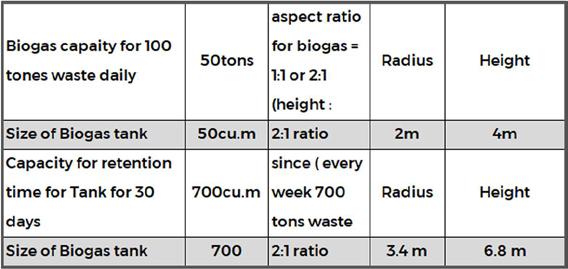


SOLAR ENERGY


 PANEL 1
PANEL 2
PANEL 1
PANEL 2
PANEL 1
PANEL 2
PANEL 1
PANEL 2
TH INK BE FOR E
YOU DR I NK
On average, only 10% of water bottles are recycled. The other 90% winds up in landfills. Make sustainable choice


ECO-REVIVE
Rethinking Waste for a Sustainable Future
Lets do it by ourselves as an individual and community, since waste management is our responsibility

WASTE WARRIORS


reCharkhaEcoSocial is a Social Enterprise, founded on the belief that, development can only be sustainable if it is bottom-up! This means, sustainable development is possible only when it begins at the grassroots and involves an empathetic understanding of the other biotic and abiotic communities.



Nashik Ploggers, established in 2019 under the visionary leadership of Mr. TejasNarendra Talware, has emerged as a formidable force in the local community, relentlessly tackling the ever-pressing issue of plastic waste management.

Their core approach revolves around the innovative concept of "plogging," a fusion of jogging and litter collection, with a particular emphasis on microplastics. In the journey, Nashik Ploggers has experienced remarkable growth, amassing a dedicated volunteer base exceeding 9000 individuals.

The Nashik Ploggers Voluntary organization Cleaning drive in Nashik at Godavari River ghat
Source : https://www.ploggersfoundation.org/media











COMMUNITY HELPERS COLLABORATORS

WEBSITE








